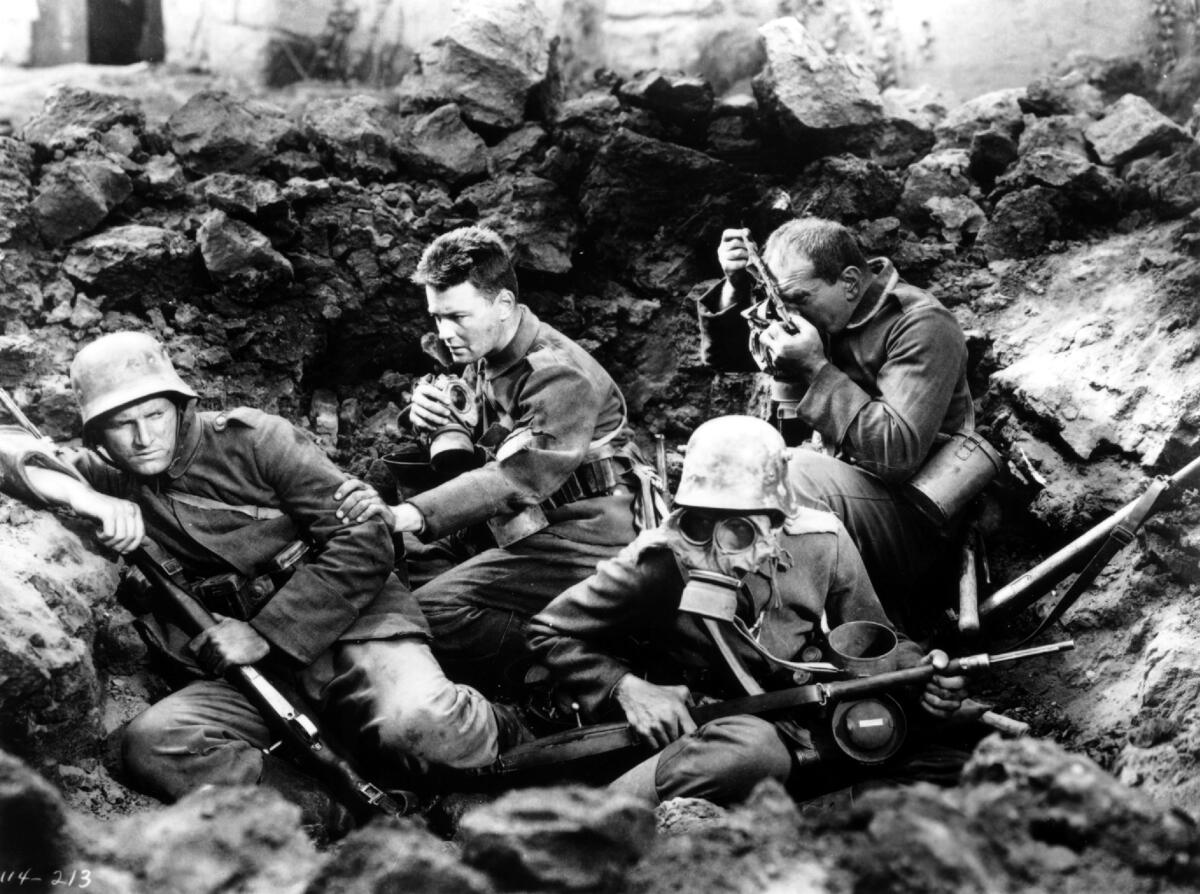From the Archives: War shown in stern reality: ‘All Quiet on Western Front’ great achievement

- Share via
It may well be called a preachment for peace. No motion picture has presented a bleaker, blacker etching of the horror of war than “All Quiet on the Western Front.”
Erich Maria Remarque’s realistic story transcribed to the screen opened last night at the Carthay Circle Theater, and produced a profound impression upon its first audience.
On the scroll of great achievements of the screen let the name of this production be deeply and darkly engraved. For until you have seen it you have never viewed the war portrayed on the motion-picture film.
That so small a thing as a rifle bullet can end a man’s life … after the thunder and the pandemonium of shell fire and barrage. …
What a picture for contrasts, this one! A little laughter here and there, and the heavy spell of hellish sadness hanging awesomely over all. …
“All Quiet On the Western Front” is one of the great productions of all time. Its battle scenes can be termed magnificent, though they are also fraught with horror.
One’s nerves grow tense over the carnage on the open field, and in trench and shell hole. There is a strange subjectivity about it all. It is as if you were living through it.
One sits with bated breath at times watching the unfoldment of this story of a young boy, who casts his school books aside to go to the front. He is caught by the glamour of patriotism. It is in the air and preached on every side.
Later he returns to that same school. The teacher asks him to tell of the glory of war. He has not heart for it. He delivers a denunciation of the whole madness. The teacher is aghast, the pupils are amazed. It does not coincide with the fervor of those who are not in the fighting throng.
There is no plot as such to “All Quiet on the Western Front.” It preserves the biographical spirit of the original. It is a sensation scenically. The strange depression hanging over shattered villages … the cold gloomy plain of No Man’s Land … the webs of barbed wire spelling entanglement before death … the earth torn apart … and clouds of dirt clods and human beings tossed high. …
Words are a feeble description of what occurs in this picture. I can see it only as a series of impressions of a terrible reality — one of the grimmest panoramas of the conflict with sound adding constantly to its uncanny realism.
In the end there is the young soldier who has survived a score of battles stretching his hand out to capture a butterfly ... a symbol of beauty in his wilderness. Then the muffled throb of a rifle shot ... the hand clenches ... and one views the youth as a member of a shadow procession marching over wooden white crosses, looking back questioningly at the strange horror of war behind.
I cannot recommend that you see this picture simply for enjoyment.
I cannot say enough, however, as to what a courageous accomplishment it is. Produced by Carl Laemmle, Jr., and directed by Lewis Milestone it will, without question, give them both a lasting place in filmdom’s corridor of fame. How it was possible to attain such remarkable accuracy in the battle episodes is a story in itself. But the delicate and intimate touches in the production are exceptionally fine, and though the story is somber there is the relieving humor here and there. No one should miss “All Quiet on the Western Front” because it is new proof of how surpassingly real the screen can be.
Lewis Ayres plays the role of the hero Paul, with fine sensitive feeling. This is what it most demands. For enlivenment there are Louis Wolheim and “Slim” Summerville — the latter being notably good, William Bakewell and Ben Alexander are importantly present for pathos. John Wray is the drill sergeant, Himmelstoss. Raymond Griffith gives a sensational portrayal of the death of the French poilu. Russell Gleason, Beryl Mercer, Arnold Lucy, Owen Davis, Jr., — the names throng in this picture — and all the smaller parts are brilliantly done.
Maxwell Anderson and George Abbott made the adaptation of the original, and their sense of the fitness of things was apparently ideal.
Introductions following the showing were in the hands of William C. DeMille, president of the Academy of Motion Picture Arts and Sciences, and he paid high tribute to the work of all. The one who deserved the greatest tribute, Mr. Milestone, was unfortunately absent.
There is a martial prelude to the picture presented by Abe Lyman and his band, which is fitting. A short cartoon comedy, “Dixie Days,” is a light event of the program.
More to Read
Only good movies
Get the Indie Focus newsletter, Mark Olsen's weekly guide to the world of cinema.
You may occasionally receive promotional content from the Los Angeles Times.









